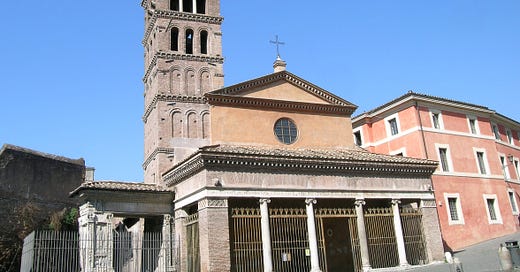Saint John Henry Cardinal Newman was a famous 19th century British convert from Anglicanism to Catholicism and theologian. Upon his elevation to the College of Cardinals by Pope Leo XIII in 1879, he would be entrusted to the care of this deaconry until his death in 1890. On Newman’s tombstone, the Latin motto ex umbris et imaginibus in veritatem (Latin for “From shadows and phantasms into truth), is written, and it reminds us of the Exodus pilgrimage that is revealed in today’s First Reading from Deuteronomy. That poetic image would be a catalyst of Newman’s conversion, which he once practiced a belief built on heresy to one built on the truth. An early church saint that closely embodies the life of that of Newman happens to be Saint George, who was Roman knight martyred for his faith under the emperor Diocletian. This is the reason why the Roman Stational Pilgrimage takes us to San Giorgio al Velabro, or Saint George in Velabro.
For the Lenten Station Churches throughout this liturgical season, I thought it would be suitable to share some reflections from George Weigel’s 2013 book, Roman Pilgrimage: The Station Churches.
At first glance, St. George in Velabro might seem to be the twin of St. Sabina: springing arches lighten the walls; fretwork windows filter light; two slender side aisles flank a wide nave covered by a wooden ceiling with painted stars. Yet St. George is decidedly the more rugged of the two, irregular in both shape and décor. Even its placement is humbler, for St. George sits in the swampy valley of the Forum. “Velabro” is derived from the Latin velum [marsh], and Roman tradition has it that here, at the base of the Palatine, when the Tiber was in flood, the infants Romulus and Remus were deposited in their basket, a first moment in the founding of the city. The church rests above the Cloaca Maxima, ancient Rome’s great sewer, and faces the Arch of Janus, built around 325 as a threshold to the meat market next door. To the left is another arch, erected in 204 in honor of Emperor Septimius Severus by the Roman money-changers. St. George is thus settled amid docks and markets, inviting blue collar locals and visiting foreigners to discover Christianity in the midst of the trappings of business. Founded in the fifth century as a deaconry where anyone could find welfare assistance from the Christian community, the church seems at home among the workers of Rome: even its columns and pavement are spoglia, stones recouped from other, older buildings. In 683, Pope Leo II dedicated the church to St. George and St. Sebastian. Sebastian, a Roman soldier, was martyred in this area, and his corpse was thrown into the Cloaca Maxima. George, however, hailed from the eastern part of the empire. Like Sebastian, he was a soldier who refused to sacrifice to the emperor; both men were tortured before being killed by their comrades-in-arms. Roman recognition of St. George coincided with the dedication of new Roman churches to Eastern saints such as Cosmas and Damian; this was the age when Byzantium nominally ruled Rome, and the Velabro became the neighborhood of Greek-speaking monks and merchants. In the ninth century, Pope Zachary donated the relic of St. George’s head to the church, but the height of its glory came during the Crusades, when the Cappadocian soldier-martyr became one of Christendom’s most celebrated heroes. In those days, a handsome porch with four Ionic columns was donated by Stefano Stella, who records in the inscription that he offered it “for the salvation of his soul”; the sturdy bell tower also dates from this time. The church was once lined with frescos; only the apse decoration, by Pietro Cavallini, Rome’s answer to the Florentine genius Giotto, remains. His Christ Flanked by Mary and Sts. Peter, George, and Sebastian has been heavily restored but adds a splash of color to the simple space. The high altar contains a splendid shrine of inlaid stone in the Cosmatesque style; the shrine guards the reliquary with St. George’s head. Fragments along the walls suggest that, like St. Sabina, the church once contained a marble choir. A 1993 bomb attack by the Italian Mafia devastated the thirteenth-century porch, which was promptly restored.




